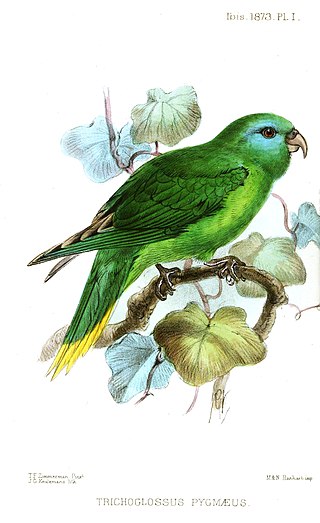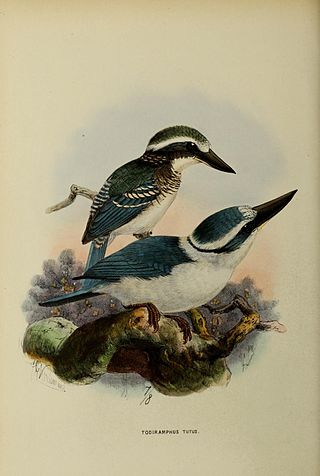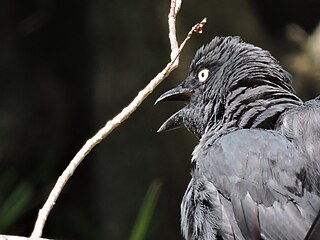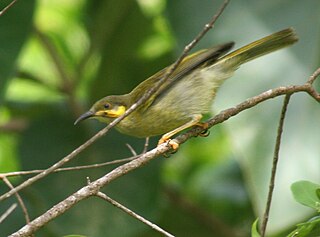
John Latham was an English physician, naturalist and author. His main works were A General Synopsis of Birds (1781–1801) and General History of Birds (1821–1828). He was able to examine specimens of Australian birds which reached England in the last twenty years of the 18th century, and was responsible for providing English names for many of them. He named some of Australia's most famous birds, including the emu, sulphur-crested cockatoo, wedge-tailed eagle, superb lyrebird, Australian magpie, magpie-lark and pheasant coucal. He was also the first to describe the hyacinth macaw. Latham has been called the "grandfather" of Australian ornithology.

The bearded barbet is an African barbet. Barbets are birds with a worldwide tropical distribution, although New World and Old World barbets are placed in different families. The barbets get their name from the bristles which fringe their heavy bills.

The salmon-crested cockatoo, also known as the Moluccan cockatoo, is a cockatoo endemic to the Seram archipelago in eastern Indonesia. At a height of up to 46–52 centimetres (1.51–1.71 ft) and weight of up to 850 grams (1.87 lb), it is among the largest of the white cockatoos. The female is slightly smaller than the male on average. It has white-pink feathers with a definite peachy glow, a slight yellow on the underwing and underside of the tail feathers and a large retractable recumbent crest which it raises when threatened, revealing hitherto concealed bright red-orange plumes to frighten potential attackers. It may also be raised in excitement or in other 'emotional' displays. Some describe the crest as "flamingo-colored". It also has one of the louder calls in the parrot world and in captivity is a capable mimic.

The friarbirds, also called leatherheads, are a groups of 18 relatively large honeyeaters in the genus Philemon. Additionally, the single member of the genus Melitograis is called the white-streaked friarbird. Friarbirds are found in Australia, Papua New Guinea, eastern Indonesia, and New Caledonia. They eat nectar, insects and other invertebrates, flowers, fruit, and seeds.

The gray-headed lovebird or Madagascar lovebird is a small species of parrot of the lovebird genus. It is a mainly green parrot. The species is sexually dimorphic and only the adult male has grey on its upper body. They are native on the island of Madagascar and are the only lovebird species which are not native on the African continent. They are the smallest of the lovebird species. It is rarely seen in aviculture and it is difficult to breed in captivity.

The northern carmine bee-eater is a brightly-coloured bird in the bee-eater family, Meropidae. It is found across northern tropical Africa, from Senegal eastwards to Somalia, Ethiopia and Kenya. It was formerly considered to be conspecific with the southern carmine bee-eater which has a carmine coloured throat rather than the blue throat of the northern species.

The black-lored parrot also known as the Buru green parrot, is a parrot endemic to the Indonesian island of Buru. It is a 40 cm (16 in) long green parrot with black lores, and a turquoise crown. Males have red beaks, and females are gray-brown. The singing is high pitched and more protracted as compared to similar species, such as great-billed parrot.

The Mascarene swiftlet or Mauritius swiftlet is a species of swift in the family Apodidae. It is found in Mauritius and Réunion, and the populations on the two islands have recently been confirmed to differ subspecifically. The nominate race francicus is found on Mauritius and the recently described race saffordi occurs on Réunion. Its natural habitats are subtropical or tropical moist lowland forest, subtropical or tropical high-altitude shrubland, subtropical or tropical high-altitude grassland, caves, arable land, and heavily degraded former forest. It is threatened by habitat loss.

The palm lorikeet is a species of parrot in the family Psittaculidae. It is found in the Santa Cruz Islands and Vanuatu. Its natural habitats are subtropical or tropical moist lowland forest, subtropical or tropical moist montane forest and plantations. It is threatened by habitat loss.

The chattering kingfisher is a species of bird in the kingfisher family Alcedinidae. The species is found in the Cook Islands and the Society Islands in French Polynesia.

The Society kingfisher or Tahiti kingfisher is a species of bird in the family Alcedinidae. It is endemic to the Society Islands of French Polynesia. Its natural habitats are subtropical or tropical moist lowland forest and subtropical or tropical moist montane forest.

The south Melanesian cuckooshrike is an uncommon species of bird in the cuckooshrike family. It is found in New Caledonia, Bougainville Island, the Solomon Islands, and Vanuatu. The species is a large (32–37 cm) cuckoo-shrike with a long square tail and all over dark grey plumage. The eye of adults is yellow, whereas that of the juvenile is dark. Its natural habitats are subtropical or tropical moist lowland forests and subtropical or tropical moist montane forests.

The Polynesian wattled honeyeater or the eastern wattled honeyeater, is a species of bird in the honeyeater family Meliphagidae. It was considered conspecific with the Fiji wattled honeyeater and the kikau.

The cliff flycatcher is a species of bird in the tyrant flycatcher family, Tyrannidae. The cliff flycatcher is the only species in the genus Hirundinea after the swallow flycatcher was merged, becoming subspecies Hirundinea ferruginea bellicosa. It is native to South America, where its natural habitats are cliffs and crags in the vicinity of subtropical or tropical dry forest, subtropical or tropical moist lowland forest, subtropical or tropical moist montane forest, and heavily degraded former forest.

The cardinal myzomela is a species of bird in the honeyeater family Meliphagidae. It is named for the scarlet color of the male. It is found in American Samoa, New Caledonia, Samoa, Solomon Islands, and Vanuatu, as well as some islands in Micronesia such as Yap. Its natural habitats are subtropical or tropical moist lowland forest and subtropical or tropical mangrove forest. It frequents areas with flowers, such as gardens. This is a small, active bird, measuring about 13 cm (5.1 in) from bill to tail. Males are red and black in coloration, females are grayish-olive, sometimes with a red cap or red head. Its long, curved bill is especially adapted for reaching into flowers for nectar. Cardinal myzomela populations have vanished from the island of Guam since the invasion of the brown tree snake.

The Jamaican becard is a species of bird in the family Tityridae. Its genus, Pachyramphus, has traditionally been placed in Cotingidae or Tyrannidae, but evidence strongly suggest it is better placed in Tityridae.

The white-eyed thrush is a species of bird in the family Turdidae that is endemic to Jamaica. Its natural habitats are subtropical or tropical moist lowland forests, subtropical or tropical moist montane forests, and heavily degraded former forest.

The Sunda pygmy woodpecker, also known as the Sunda woodpecker, is a species of bird in the family Picidae. It is found in Brunei, Indonesia, Malaysia, and Singapore. Some taxonomic authorities continue to place this species in the genus Dendrocopos or Picoides.

The Tanimbar friarbird is a species of bird in the family Meliphagidae. It is endemic to the Kai and Tanimbar Islands, Indonesia.




















